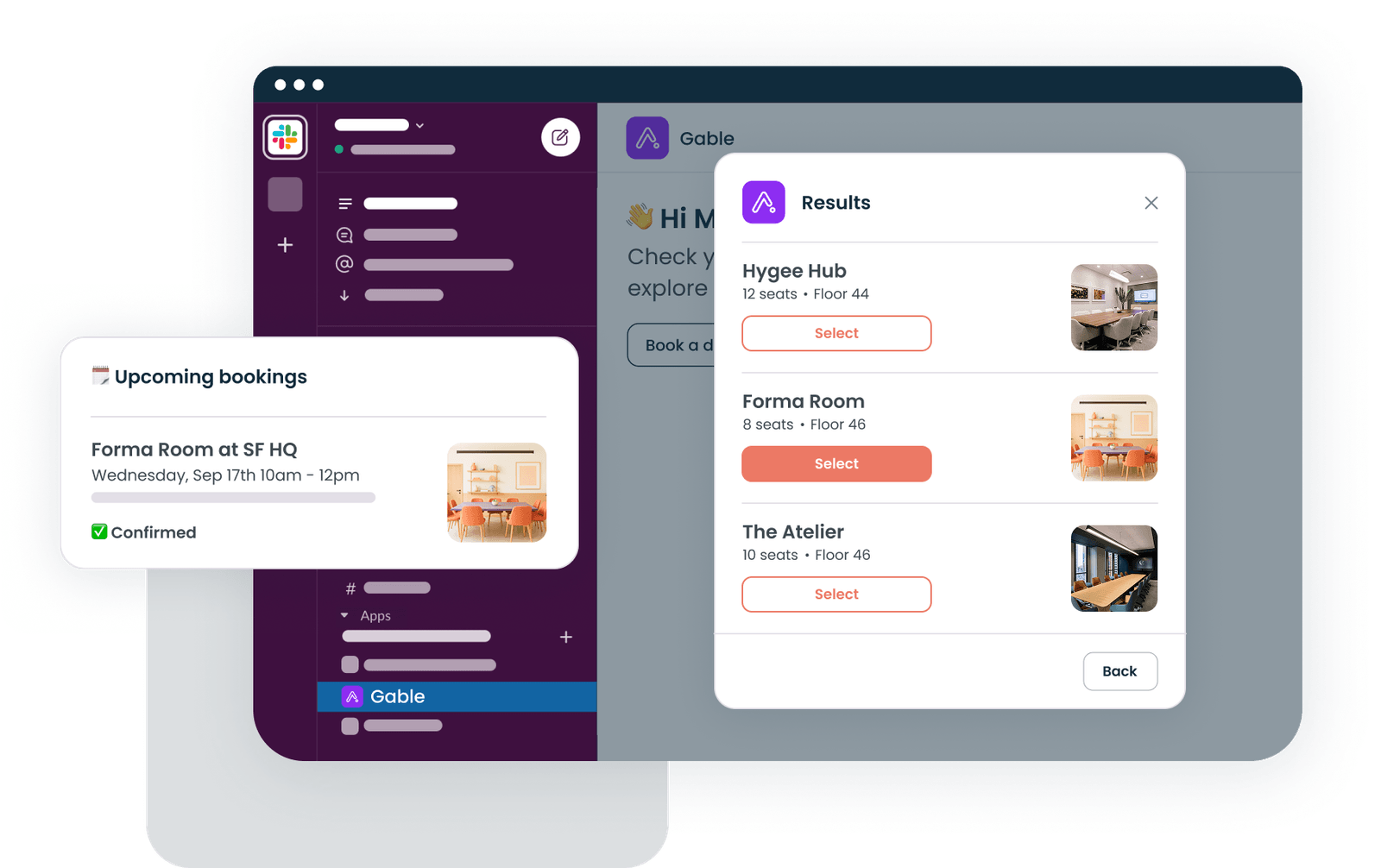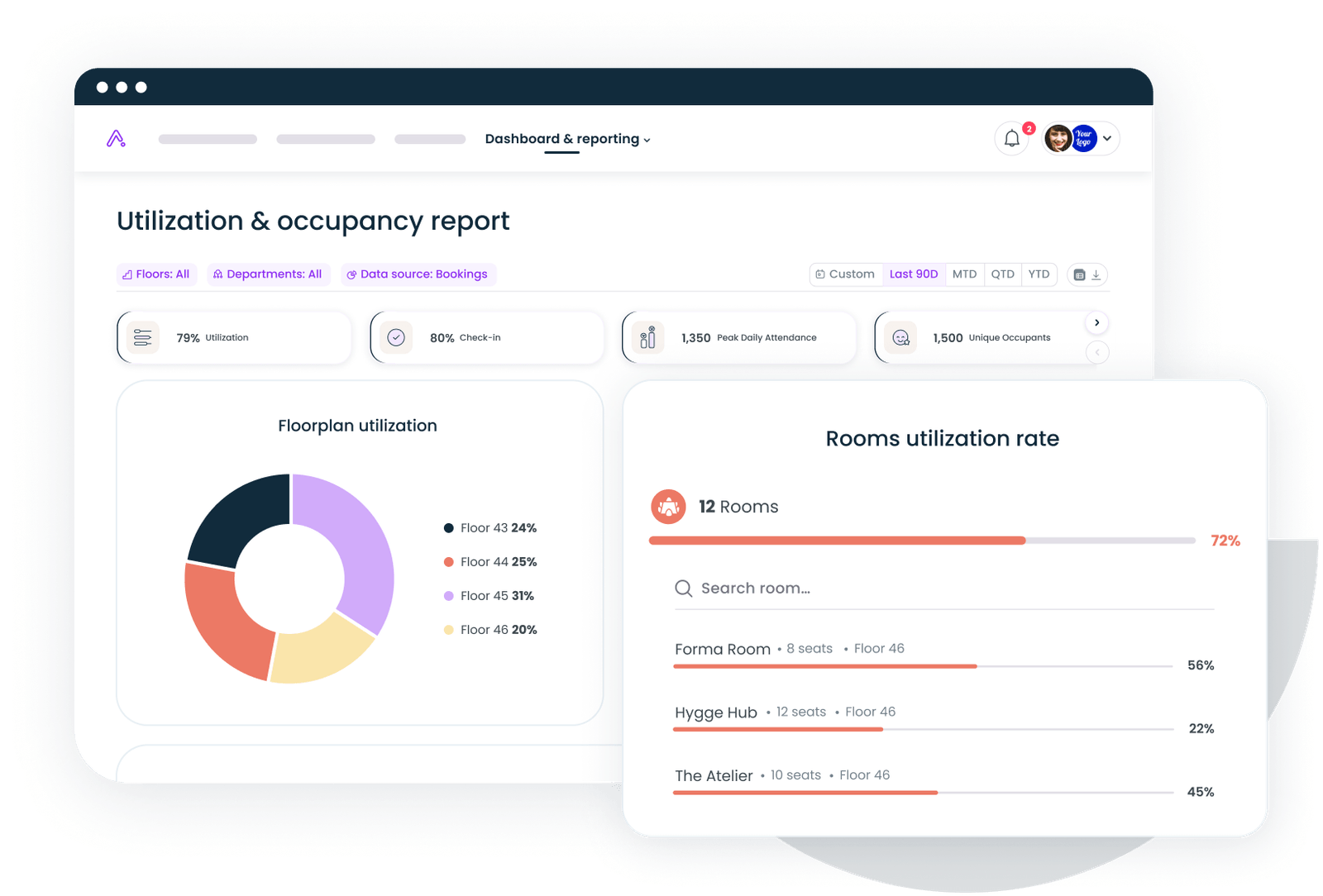Walk into any modern office and you'll notice something off. Those traditional conference rooms with long tables seating 20 people? They're sitting empty most of the day. Meanwhile, employees are huddled around laptops in hallways or fighting for the few available small spaces. Research shows that 73% of meetings involve only 2 to 4 people, yet 53% of conference rooms are designed for meetings of 7 or more.
Enter huddle rooms—compact, tech-enabled collaboration spaces purpose-built for small groups. These aren't your traditional meeting spaces with dated technology. Huddle rooms offer something better: flexible, accessible spaces where up to six people can connect, brainstorm, and make decisions without having to book a big conference room weeks in advance.
What is a huddle room?
A huddle room is a small meeting space designed for two to six people to collaborate quickly and informally. Unlike traditional meeting rooms that require advance scheduling and formal agendas, huddle spaces are meant for spontaneous collaboration and focused discussions.
The huddle room meaning comes from sports—those quick team circles where players regroup and strategize. In the workplace, small huddle rooms serve the same purpose. They're where your team can gather to hash out a problem, align on next steps, or connect with remote team members through video calls without occupying a large conference room.
You'll find huddle spaces tucked into corners of open-plan offices, carved out of unused nooks, or integrated as glassed-in structures. At roughly 100 to 250 square feet, these small huddle spaces pack a serious impact. With an estimated 50 million huddle rooms globally, they typically include a small table, a few chairs, a video bar for hybrid meetings, and the collaboration technology needed for both in-person and remote sessions.
Why huddle rooms matter for hybrid teams
According to Gallup, 74% of employees consider hybrid work a non-negotiable benefit. Your office is now where teams come together for collaboration, relationship-building, and meaningful work that benefits from being in the same room.
The problem? You're trying to hash something out with coworkers, chatting across desks over ambient noise. You could book a big conference room, but reserving an 8-person space for a 20-minute chat with two colleagues feels like overkill. Huddle rooms solve this by providing a dedicated huddle space for focused discussion without scheduling friction.
Research shows that 40% of office interactions involve remote participants, and 56% of meetings are hybrid. With AV equipment, video conferencing, and screen sharing tools, huddle rooms make remote collaboration frictionless. The psychology works too—everyone is closer, there's no "back of the room," and creativity flows more freely.

Creating effective huddle rooms is just one piece of building a workplace that works for hybrid teams. Learn how to design your entire office strategy around real employee needs and usage data.
Read more
The benefits of huddle rooms for your workplace
Efficiency and speed. With no need to book in advance for ad hoc meetings, small teams can quickly gather for one-on-ones or standups without the overhead of scheduling meetings in larger spaces.
Better hybrid collaboration. The best huddle rooms are equipped with reliable audio-visual tools that make video meetings seamless. They level the playing field for hybrid teams and ensure remote team members aren't left out.
Smart space optimization. Huddle rooms make efficient use of awkwardly shaped areas in many offices, converting them into collaboration spaces. They reduce demand for larger groups to occupy big conference rooms, freeing those up for appropriate use.
Cost-effective solutions. Compared to boardrooms with cutting-edge technology, huddle rooms are inexpensive. The technology needed —a screen, a video bar, and comfortable chairs —costs far less than equipping traditional meeting spaces with advanced technology.
Employee satisfaction. When employees have spaces that match how they work, morale improves. The ability to find a comfortable space for idea generation or content sharing without barriers makes the office feel like it supports work rather than hinders it.
What makes an effective huddle room?
The right size and setup. Small huddle rooms typically accommodate two to six people comfortably. A small table with a few chairs works for most scenarios, though some organizations prefer standing-height tables. The key is flexibility.
Quality technology that works. Your huddle room should include a large monitor, a webcam with a wide-angle lens, microphones and speakers with noise-canceling capabilities, and easy connectivity. Many effective huddle rooms use a video bar—an all-in-one device that's clutter-free.
The technology should work without IT support. Plug and play is the standard. Integration with Microsoft Teams, Zoom, and Google Meet should be seamless, allowing teams to use their own device without hassle.
Acoustic privacy and comfort. Good soundproofing ensures conversations stay private and outside noise doesn't disrupt meetings. Comfortable chairs and proper lighting encourage people to use the space.
Visual tools for collaboration. A whiteboard or virtual whiteboard integration lets teams share ideas during brainstorming sessions. In hybrid meetings where some participants are remote, a digital whiteboard creates more inclusive collaboration.
Clear availability. Workspace management software lets teams see real-time availability and avoid the awkward "Is anyone using this room?" dance.
How to set up huddle rooms in your office
Audit your existing space. Look for underutilized corners, old phone booths, small conference rooms, or partitioned areas in your open office layout. The goal is spots that are accessible yet provide visual and acoustic privacy.
Start small and iterate. Begin with one or two huddle spaces in high-traffic areas. Monitor usage through your office management platform to understand demand, then expand based on data.
Prioritize the technology experience. Invest in quality audio and video equipment. Poor audio quality kills hybrid meetings. Test your setup thoroughly with in-office and remote participants.
Design for different work styles. Some huddle rooms work best with a traditional small table and chairs. Others benefit from a lounge-style, comfortable space. Standing setups work for short check-ins. Create a mix of huddle room types.
Keep it simple and welcoming. A clutter-free environment helps people focus. Add plants, good lighting, and color to make the space inviting. The best huddle rooms feel intentional and comfortable.
Stop wasting time hunting for available rooms. Gable Offices gives you real-time visibility into space usage, seamless booking for desks and meeting rooms, and the analytics you need to make smarter workplace decisions.
Explore Gable Offices
The technology that powers modern huddle rooms
Video conferencing platforms. The foundation of any hybrid-ready huddle space is reliable video meeting capability. Most organizations standardize on platforms your team already uses for remote meetings.
All-in-one video bars. These combine a camera, microphones, and speakers in a single unit. They're purpose-built for small spaces, offering wide-angle views, intelligent framing, and audio processing that eliminates echo.
Wireless presentation systems. Screen sharing should be effortless. Modern wireless casting lets people share content from their own devices without cables, supporting both in-room presentation and remote collaboration.
Room scheduling displays. Digital panels outside huddle rooms show real-time availability and integrate with your calendar system to prevent double-bookings.
Smart sensors and analytics. Advanced huddle rooms track actual utilization versus bookings. This data helps workplace leaders understand which spaces are used and where to invest to improve office space efficiency.
Common challenges and how to solve them
Technology frustration. If people struggle to connect, they'll stop using the room. Solution: Invest in plug-and-play systems and standardize technology across all huddle spaces.
Acoustic privacy concerns. In open offices, conversations can leak out or outside noise disrupts video calls. Solution: Install sound-absorbing panels and use solid doors.
Scheduling conflicts. When demand is high, conflicts arise. Solution: Add more huddle rooms based on usage data from your workplace analytics. Create booking policies that auto-release rooms if no one checks in.
Remote participants feel secondary. Even with video technology, remote people can feel like afterthoughts. Solution: Position the camera at eye level, ensure proper lighting, and use a large monitor that makes remote faces prominent.
Making huddle rooms work for distributed teams
Create consistent experiences. When you have offices in different cities, standardize your huddle room design and technology. Consistency reduces friction and makes collaboration across locations easier.
Supplement with flexible workspaces. Not every employee works near a company office. Flexible workspaces and coworking spaces provide professional huddle rooms that distributed team members can book on demand.
Use huddle rooms for virtual team bonding. Small groups from the same location can gather in a huddle space for virtual team events or social time with remote workers, creating stronger bonds than everyone dialing in separately.
Coordinate "anchor days." When planning days for team gatherings, ensure you have adequate huddle space for small-group collaboration. Using workplace data to inform these decisions helps you balance attendance with resources.
The future of huddle rooms
The huddle room market is growing rapidly. Research shows the global huddle room solutions market reached $2.87 billion in 2024 and is projected to grow at 14.8% annually, reaching $9.09 billion by 2033. Key trends shaping huddle spaces:
AI-powered meeting experiences. Features like automatic framing, real-time transcription, and background noise suppression are becoming standard in the modern workplace.
Greater focus on equity. Organizations are investing in technology that equalizes the experience for in-room and remote participants through spatial audio and interactive displays.
Integration with workplace platforms. Huddle rooms connect with booking systems, space utilization sensors, and analytics platforms as part of a broader workplace ecosystem.
Flexibility as default. The best huddle rooms support multiple use cases—small team meetups, one-on-one meetings, focused work, and impromptu brainstorming in the same room.
Optimize office space, support hybrid teams, and make data-driven workplace decisions. From room scheduling to real-time analytics, Gable gives you the tools to run an efficient office, everywhere.
Get a demo





.svg)





.svg)
















.svg)













